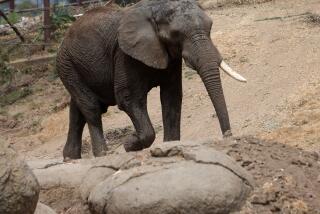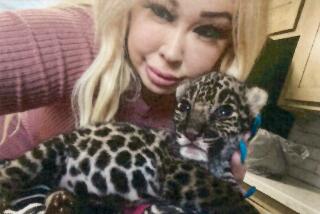COLUMN ONE : Building a Modern Noah’s Ark : Captive breeding of endangered species is proliferating at zoos and aquariums. But the practice is costly and risky. Many animals die when released into the wild.
- Share via
A slender red wolf paces back and forth on long, stick legs, her eyes fastened on her human keeper just beyond the cyclone fence of her enclosure. It is a tree-shaded affair, with an artificial brook made of concrete and recycled water.
Although on display at the Los Angeles Zoo, the animal has a higher purpose than mere exhibition. She is there to breed, to participate in a scientific gamble that, if successful, will enable her descendants to hunt for rabbits and squirrels near real brooks instead of awaiting a keeper with dog kibble next to an artificial one.
On the brink of extinction a decade ago, the red wolf is among dozens of endangered species in North America whose future in the wild hinges precariously on the still experimental but rapidly growing science of captive breeding and reintroduction.
“What we are basically doing is taking animals and putting them into a savings account, so if things change at some future time, we might be able to let them go,” said Roland Smith, senior research biologist at Point Defiance Zoo and Aquarium in Tacoma, Wash., and a coordinator of the red wolf breeding program.
Despite recent progress and encouraging new techniques, captive breeding remains a risky and costly practice, embraced by environmental groups only as a last resort. “People jump to it when it is not needed,” said Noel Snyder, a former U.S. Fish and Wildlife Service biologist who helps run a release program for the endangered thick-billed parrot.
The limitations of the programs have not diminished their popularity. Supporters talk about a coming “demographic winter” in which a human population explosion will threaten more species, turning breeding programs into a kind of Noah’s Ark.
“A lot of people who criticize captive breeding just don’t realize what a desperate situation wildlife is in now and will be in the next 20 years,” said Michael Hutchins, director of conservation and science of the American Assn. of Zoological Parks and Aquariums. “We’re talking about a human population that is going to double in many areas of the world after the year 2000.”
The often extreme efforts needed to spare wildlife from extinction are justified by conservationists on scientific as well as moral and aesthetic grounds. Once a species vanishes, others that interact with it or depend upon it may also falter--and some of these may have medicinal or commercial value. Eventually, the disruption of ecosystems could jeopardize human survival.
Critics of endangered species protection counter that extinctions are “natural,” even if hurried by man’s actions. Even many who support protection contend that species should be allowed to die “in dignity” in the wild rather than face the unnatural confinement of captivity.
As debate continues, endangered populations from toads to ferrets to condors are being collected from the wild for breeding and later release by government wildlife agencies, zoos, aquariums and private conservation organizations. In some cases, the captive populations returned to the wild are descendants of longtime zoo residents.
Zoos and aquariums in North America house 56 breeding programs, mostly for endangered or threatened species. Although the efforts are undertaken with the goal of bolstering wild populations, only about 25% of the programs are scheduled to return endangered species to the wild in the next several years.
“We don’t know a lot about how to release animals into the wild and have them survive,” said Hutchins. “The technologies have not developed yet. We just started doing this a decade ago.”
Many of the animals die when released. A 1989 study published in Science magazine found that attempts to put captive-bred species into the wild succeeded only 38% of the time.
Part of the problem is that captivity can change the animal, physiologically and behaviorally. In the wild, there is natural selection: Genes from animals that are best able to survive come to dominate a population. A different sort of selection can occur in captivity: Genetic traits suited to confinement become more dominant.
In most cases, it is difficult to distinguish whether changes are genetic or environmental. Gouldian finches bred in captivity for 30 years are larger and less active than the wild birds and no longer have one of their calls. Biologist Snyder said some of the changes may be genetic.
Several generations of captivity led to an alteration in the size of the small intestine of the red grouse; a different diet in captivity may have triggered the change. If returned to the wild, the birds would have trouble digesting their natural food.
Captivity also can rob an animal of its natural behavior. Golden lion tamarins, an endangered squirrel-sized monkey from Brazil, often do not know how to peel a banana or jump from branches after being raised in a zoo.
Lindsey Kocincki, an animal keeper at the Los Angeles Zoo, was so excited about seeing some of the zoo’s monkeys released to the wild two years ago that she paid her own way to Brazil’s Atlantic rain forest to witness their reintroduction. A strike by agricultural inspectors prevented the animals from leaving the Brazilian airport during her visit.
At first, the disappointment of missing the long-awaited event was painful. “You have this real positive view that they are going to open the door and say, ‘We’re free. All right!’ ” she said.
But after watching monkeys from other zoos released, she was not so sorry. Freedom frustrated and frightened the captive-bred animals; they did not know how to navigate a forest.
Kocincki particularly remembers a female monkey that repeatedly fell 30 feet to 50 feet from a tree because the animal could not balance itself on a moving branch. The perches in the animal’s pen had been stable, not flexible like a tree’s limb.
“All four legs would go out and she would just drop to the ground,” the zoo keeper said.
Captive breeding of some birds also has been troublesome. An endangered whooping crane reared by hand by a zoo manager grew up to relate better to humans than to its own species.
The tall, elegant crane so identified with humans that a man had to spend five years with her bonding and doing courtship rituals to get her to reproduce. In the wild, whooping cranes mate for life and will not produce an egg without having formed a bond with a male.
The ornithologist set up office in the crane’s quarters and performed such mating rituals as a courtship dance. He had learned the behavior by studying other cranes. The bird was bred successfully through artificial insemination.
“They tried her with different people, besides this one fellow, but she didn’t like them,” said Claire Mirande, bird curator for the International Crane Foundation, a nonprofit preservation group.
Tom Thorne, who is overseeing a captive breeding program for endangered black-footed ferrets in Wyoming, said special care is taken not to tame the weasel-like creatures, which still bark and bare their teeth at humans.
In preparation for the animals’ release this year, biologists have been experimenting with a relative, the more plentiful Siberian polecat, to learn what to anticipate. So far, few polecats released in the wild have survived. Thorne figures the animals, raised for generations in a fur farm, became semi-domesticated.
“Very few live more than a couple of days,” said Thorne, a veterinarian with the Wyoming Game and Fish Department. “They don’t respond quickly to predators, and some have nearly starved to death because they don’t know how to hunt.”
Captive breeding also can jeopardize the ability of some wildlife to migrate. From 1978 to 1990, the U.S. Fish and Wildlife Service and other agencies took eggs from the endangered Kemp’s ridley sea turtle into captivity.
After they hatched, the young were released briefly to waters off Padre Island National Seashore in Texas in hopes that the turtles would think they began life there. They were then placed in tanks where they grew stronger before being released in the Gulf of Mexico.
In the wild, sea turtles return to their hatching site to nest. But the captive-bred turtles never made it back to Padre Island.
“We don’t know whether the ones bred in captivity have all the right clues to come back to their beach,” said James Tate Jr., a federal wildlife biologist.
Efforts are being made to simulate the wild more carefully in captivity. For captive-bred crane chicks, biologists use tape recordings of the bird’s trumpeting calls and mirrors to help ensure the birds identify with their own species. The cranes’ keepers sometimes disguise their humanity by dressing in costume.
For cranes that normally breed in the far north, artificial light is increased to simulate longer days. For birds that breed in the rainy season, sprinklers are used.
The managers of the California condor program are similarly vigilant in their efforts to prevent the huge, stately birds from becoming domesticated in captivity.
Condor chicks are handled by condor hand puppets. The chicks become so attached to their surrogate parent that they will distinguish and attack a strange puppet. To minimize human contact, scientists observe the bird only from behind one-way glass.
In many cases, breeding efforts fail because scientists do not know enough about the species’ behaviors. Thorne said the ferret program, relying on inaccurate field reports, initially tried to breed the animal in February and March, two months before they were ready. “We thought we would never get them bred,” he said.
Tamarins began to mate successfully in captivity only after scientists discovered that the monkeys were monogamous and did not like to mate in the presence of groups.
Because even one mistake could mean extinction, animal keepers and scientists who breed endangered species tend to feel enormous pressure.
“It is scary is what it is,” said Bob Seibels, bird curator at Riverbanks Zoological Park in South Carolina and a breeder of the endangered Bali myna bird. “I feel that every day . . . I am playing God.”
Seibels said that efforts to breed the threatened Florida dusky seaside sparrow were hampered because zoos did not want their limited space used for “dumpy little brown birds that the public couldn’t care less about,” a description that fits many endangered birds.
“I was called, and I did some soul-searching and decided I could not devote a lot of my cage space to a bird that had virtually zero appeal in exhibition value,” Seibels said.
The dusky was declared extinct this year.
The choices of what to save are difficult, in part, because the costs of captive breeding are high, ranging from tens and hundreds of thousands of dollars to $1 million a year for a single species.
Critics of captive breeding contend that other alternatives, such as habitat acquisition, might be more effective because breeding programs typically save one species whereas preserving open space can protect hundreds. Some conservationists worry that policy-makers are beginning to see captive breeding as a way to mitigate the loss of animals from such economic activities as logging.
“Captive breeding is oftentimes the first suggestion out of the mouth of anybody whose project or development plan conflicts with an endangered species,” said Michael Bean, chairman of the wildlife fund for the Environmental Defense Fund, a national environmental group.
Shrimpers have proposed captive breeding of sea turtles as an alternative to requiring fishermen to use turtle excluder devices to protect the endangered species. The fishermen say the devices reduce their catch.
In the Pacific Northwest, some logging advocates have argued that the northern spotted owl can be protected in zoos rather than in old-growth forests. “Two in a Zoo,” reads a bumper sticker produced after efforts were made to curtail logging to protect the owl.
Tate, the biologist in the U.S. Fish and Wildlife Service’s endangered species division, notes that the purpose of the federal Endangered Species Act is to conserve ecosystems on which the species depend. Captive breeding, although necessary for some species, detracts from that goal by focusing primarily on the animals, he said.
After the last California condors were taken into captivity in 1987, attempts to build on their habitat increased, according to Mark Palmer, a Sierra Club activist. “The further you get away from the condor being there, the more difficult it is to restrict development that will be hazardous to condors if they ever are released back to the wild,” he said.
Palmer said that poisonings from lead bullets in carrion the condors ate were partly responsible for the birds’ decline and “the problem is still out there.” In many cases, he and other conservationists say, captive breeding should be accompanied by stronger efforts to correct the problems that were hastening extinction.
To protect cattle grazing, government agencies and private ranchers have poisoned prairie dogs, the primary food source of the black-footed ferret. Even as the U.S. Fish and Wildlife Service struggles to save the ferret, the U.S. Forest Service continues to poison part of a prairie dog complex in South Dakota’s Conata Basin, a possible site for a ferret reintroduction.
Zoos are responding by trying to focus more of their efforts on raising money to save habitat, fight poaching and educate the public about the value of the species. Although many zoos initially turned to captive breeding out of self-interest--wild animals had become too scarce to be captured for exhibition--they are increasingly breeding the animals as part of a larger conservation-oriented mission.
They and other proponents of captive breeding note that many species, including the condor, ferret and red wolf, might be extinct already had they not been taken from the wild for captive propagation.
Even the American bison may owe its survival to captive breeding. Bison bred in the Bronx Zoo were reintroduced to the wild in the early 1900s to bolster rapidly declining wild herds.
Although there are many accounts of progress in modern captive breeding programs--zoo-bred endangered Arabian oryx and tamarins are reproducing in the wild--scientists say it will take decades before they know whether many current efforts work.
Because endangered populations are small, birth defects and reproductive problems from inbreeding can kill off a species. A species generally is not considered out of danger until several generations reproduce in the wild. The species also may be condemned by the same problems that endangered it in the first place.
Even though the California condor captive breeding program has amazed some skeptics--the population has grown from 27 to 48 in captivity--and some birds are likely to be released this year, the species still could be doomed by inbreeding and environmental threats.
“If the California condor survives, it will be a miracle,” said Hutchins, who as the zoological association’s conservation director has some oversight for the condor breeding program.
Roland Smith, who is helping manage the endangered red wolf breeding effort, also is not ready to take any bows.
The wolf, indigenous to the southeastern United States, became extinct in the wild in 1980. Since 1987, 56 zoo-bred wolves have been released in the wild, and at least 20 of them or their offspring are alive.
“We don’t know yet how we are doing in the red wolf program,” Smith said. “We’re like the guy who falls out of the window and is asked on his way down, ‘How’s it going?’ He replies, ‘So far, so good.’ ”
Breeding in Captivity RED WOLF
Description: Can weigh up to 80 pounds. Color varies from grayish-brown to reddish and black. Runs with its tail horizontal and hunts small mammals.
Background: Once indigenous to most of the southeastern United States, red wolf became extinct in the wild in 1980.
Breeding Update: Since then, 56 zoo-bred wolves have been released in wild; at least 20 of them or offspring are still alive.
BLACK-FOOTED FERRET
Description: Weasel-like nocturnal animal, about 15 to 18 inches in length with another five to six inches of tail.
Background: Feeds mainly on prairie dogs, which are destroyed as farm pests. Drastic decline in ferrets has resulted.
Breeding Update: Once abundant in prairie states; none have been seen in wild since 1987. Currently, about 179 adult ferrets and 22 babies are being bred in captivity.
WHOOPING CRANE
Description: Omnivorous bird can grow up to 4 1/2 feet tall. Feeds on grain, plants, insects, frogs.
Background: Breeds in Canada and winters on the Texas Gulf Coast in wetland prairie habitats. Exceedingly rare in the wild now, their migrations are monitored by both the U.S. and Canadian governments.
Breeding Update: Currently, 135 whooping cranes survive in the wild and 66 are being captively bred.
GOLDEN LION TAMARIN
Description: One of the world’s smallest monkeys; usually measures less than one foot long, not including the tail, and weighs under one pound. Lives in lowland rain forests of southeastern Brazil. Eats insects and fruit.
Background: Endangered because of destruction of its forest habitat for lumber, agriculture, pasture and housing. Also threatened by the pet trade.
Breeding Update: About 400 tamarins are left in Brazil’s rain forest. Since 1984, 89 captively bred tamarins have been released in the wild; about 35 are still alive.
SOURCE: Macmillan Illustrated Animal Encyclopedia; Harper & Row’s Complete Field Guide to North American Wildlife; Wyoming Fish and Game Dept.; International Crane Foundation.
Compiled by Times editorial researcher Tracy Thomas.
More to Read
Sign up for Essential California
The most important California stories and recommendations in your inbox every morning.
You may occasionally receive promotional content from the Los Angeles Times.











